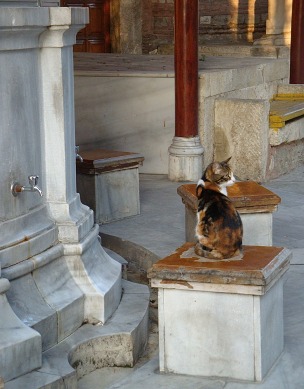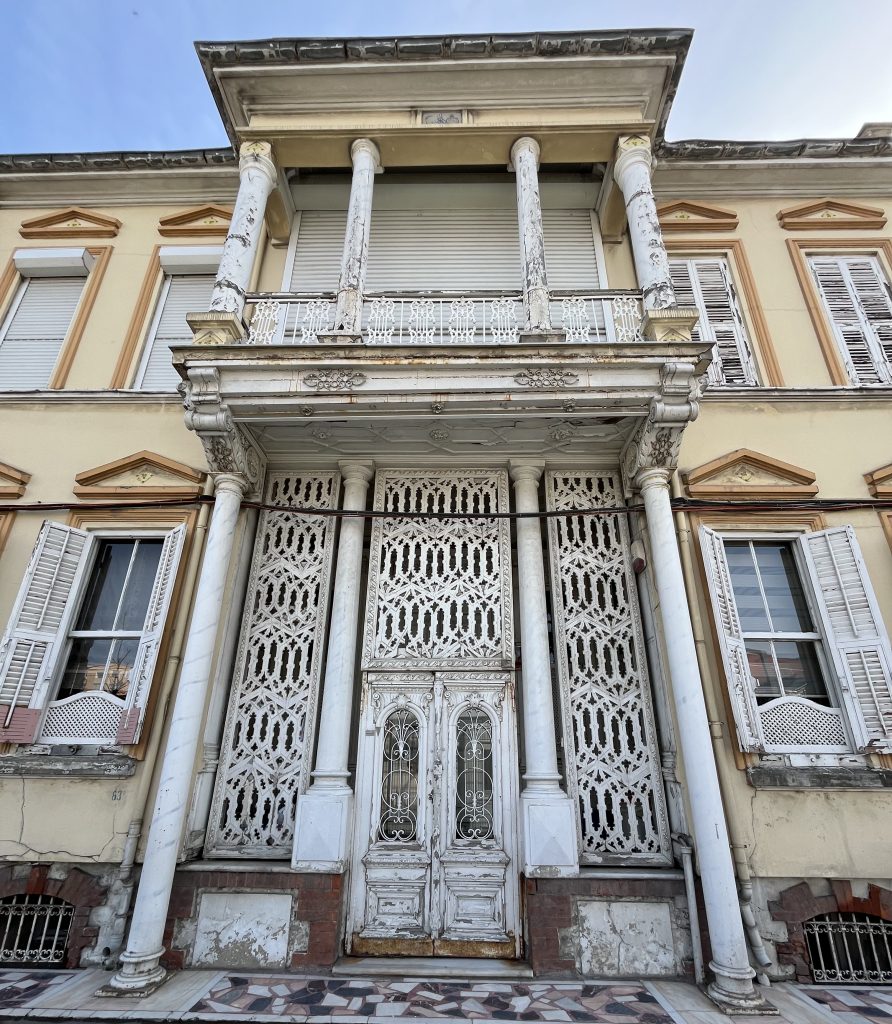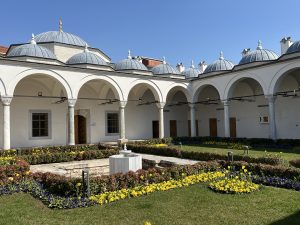
Rather unexpectedly, the part of Old İstanbul around Cerrahpaşa and Haseki remains completely off-the beaten-track to tourists despite being within easy walking distance of Aksaray. Yet historically this was a very important part of the city, the place where the old slave market used to stand and thus the place where some of the women who rose to power in the Topkapı Palace harem changed hands for money on their path to the sultan’s bed. But it was also a part of town favoured by several dignitaries of the Ottoman court who chose to adorn it with magnificent mosque complexes, some of them by the great Mimar Sinan.
Around Cerrahpaşa
One way to find Cerrahpaşa is to alight from the tram at Aksaray, cross the busy interchange and look for the brick-built Ebubekir Paşa Sibyan Mekteb (primary school, 1724) which has three fountains and a water tower attached to it. From there you should head along Namık Kemal Caddesi to the Cerrahpaşa Cami, which was built in 1593 by Davud Ağa, a pupil of Sinan who succeeded him as chief architect. In the grounds stands the tomb of Cerrah (Surgeon) Paşa, the barber who had the honour of circumcising the future Mehmed III and who was awarded the title of surgeon for his pains (as well as giving his name to the district).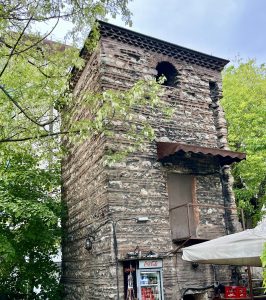
More or less across the road is the small Geverhan Sultan Misafirhanesi (Guesthouse), built in 1568 for a daughter of Sultan Selim II and restored in the 1970s. It is now used by Kızılay (Red Crescent).
If you continue along Cerrahpaşa Caddesi and then turn left along Haseki Kadın Sokağı you will come to the enormous Bulgur Palas, built in 1912 in the style known as First National Architecture for Mehmed Habib Bey, who made a fortune in cracked wheat (hence the name) and went on to become an MP for Bolu. One of the architects who worked on it was Giulio Mongeri, who was also responsible for St. Anthony’s Church on İstiklal Caddesi as well as for the Maçka Palas building that now houses the Park Hyatt Hotel. The Palas was completed restored in the 2020s and offers a magnificent view from the turret that, from a distance, resembles a flying saucer.
If, instead, you turn right along Haseki Kadın Sokağı you will come to one of the city’s more curious and easily overlooked monuments, namely the base of the Column of Arcadius, erected in his own honour by the Emperor Arcadius in 402. The column was torn down for safety reasons in 1715, which means that the base is now squeezed in between two buildings. In winter it’s clearly visible, although in summer it’s largely obscured by foliage. At one time you could actually get inside the base but sadly no longer.
Believe it or not, the area around this column, where there is now an innocent children’s playground, was once the Roman Forum of Arcadius, and then the site of the Avrat Pazarı, or Female Slave Market, which survived until 1847. Today there’s not even a commemorative plaque to show for its history but it’s thought that among the many women to have passed through it were Roxelana, who became the wife of Sultan Süleyman the Magnificent; Kösem Sultan, the wife of Sultan Ahmed I and, as co-regent for her sons and grandson, one of the most powerful of all the Ottoman women; and Mihrişah Sultan, the mother of Sultan Selim III.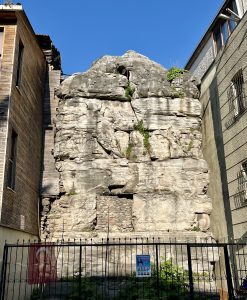
At the end of Haseki Sultan Sokağı you will come to the Bayrampaşa mosque complex, which is split in two by the road with the mosque on the left-hand side of the road and the medrese (theological seminary) on the right. Bayram Paşa was a grand vizier to Sultan Murad IV, who died during the campaign to recapture Baghdad in 1638 and who gave his name to the area of İstanbul around the Esenler bus station. Bayram Paşa’s tomb has been restored, and a mescid (chapel) and dervish tekke (lodge) that formed part of the complex now house a women’s clinic.
If you turn left onto Haseki Caddesi you will come to the Haseki Hürrem mosque complex, built by Sinan for Roxelana in 1539. It’s the third largest such complex in the city after the Fatih and Süleymaniye models, which makes it all the more remarkable that it is so little known or visited. The mosque itself stands on the left-hand side of the road in a cramped courtyard but the medrese over the road must once have been magnificent, to judge from the delicate tiled panels removed from above its windows and placed in the İstanbul Archaeological Museum for safekeeping. Behind it the imaret (soup kitchen) bristles with chimneys alongside a splendid hospital building.
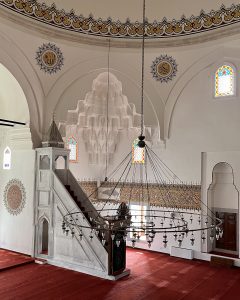 A bit of zigzagging around the back streets will bring you to the older Davutpaşa Cami, built for Davud Paşa, a grand vizier to Sultan Beyazıd II. The mosque dates back to 1485 and is a magnificent example of early Ottoman, pre-Sinan architecture with huge stalactite pendentives in the corners of the prayer hall. The portico reuses columns from a lost Byzantine building.
A bit of zigzagging around the back streets will bring you to the older Davutpaşa Cami, built for Davud Paşa, a grand vizier to Sultan Beyazıd II. The mosque dates back to 1485 and is a magnificent example of early Ottoman, pre-Sinan architecture with huge stalactite pendentives in the corners of the prayer hall. The portico reuses columns from a lost Byzantine building.
Across the road, the restored medrese is one of the oldest in the city and now houses a library. Its peaceful courtyard is surrounded by reused columns whose capitals are carved with crosses, presumably from a lost Byzantine church in the vicinity.
A little way west of Cerrahpaşa Hospital is the Fatih İbrahim Paşa Medresesi, which was erected in 1560 but badly damaged by an earthquake in 1894. It has now been effectively rebuilt.
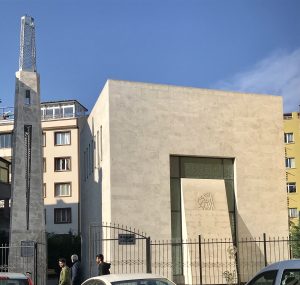
If you head up Ali Şir Nevai Sokağı you will come to an unexpected find for this part of town – the hyper-modern Şüca Mehmet Çavüs Cami, built in 2017 on the site of a lost 15th-century mosque and one of the most original examples of modern mosque architecture in the city despite its small size.
Not far from here is the fascinating if more conventional Hekimoğlu Ali Paşa Cami, built in 1734-5 in a style that segues neatly from classical Sinanesque into early baroque as exemplified by its main entrance, which blends traditional stalactite decoration with more rococo elements. The mosque itself is particularly beautiful but you should make sure not to miss either the lovely sebil (water dispensary) built into the walls on the corner, or the wonderful library housed above the main gate. Books here used to be encased in a cage above the ground and had to be accessed via a ladder. In 2024 it was undergoing restoration.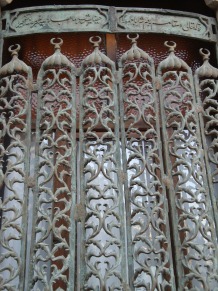 Beautiful grille on Hekimoğlu Ali Paşa Cami sebil
Beautiful grille on Hekimoğlu Ali Paşa Cami sebil
Across the road is the locked and inaccessible 19th-century Greek Dormition of the Virgin Mary Church or Altımermer Kilise. A few streets to the north along Sırrıpaşa Sokağı is another curious reminder of the Byzantine period in the shape of the Cistern of Mocius, a vast open-air reservoir that was probably used to store water for irrigation in Byzantine times. At 25,000 sqm, it’s big enough to enclose a park and children’s play area in what is officially called the Fındıkzade Çukurbostan Semt Parkı. It takes its name from a lost Byzantine church that used to stand nearby.
From the Hekimoğlu Ali Paşa Cami you can heard south to reach Cerrahpaşa station. If you do this you will pass on the left the small rebuilt Esekapı Cami (Isa or Jesus Gate Mosque). This occupies the site of a late Byzantine church, hence all the columns and other masonry lying in the garden. In 1509 an earthquake destroyed the eponymous gate. Then in the 1550s the vizier Hadım İbrahim Paşa had the church converted into a mosque for which Sinan designed a medrese and dershane. In 1894 an earthquake levelled the mosque which was abandoned and only rebuilt in the 2010s right beside a university library. Incidentally, before the 5th century when the original Constantinople was defended by the Constantinian Wall, Esekapı would have been the main gateway into the city.
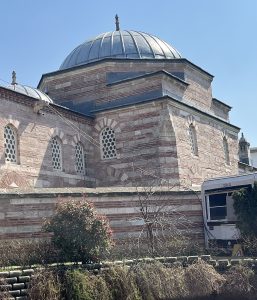
If you don’t want to catch the train to Sirkeci and instead continue west along Kocamustafapaşa Caddesi you will come to a busy square where many buses terminate. Here, too, is the inconspicuous Ramazan Efendi Cami, the last work of Sinan, designed in 1586 when he was 96. It contains a fine collection of İznik tiles although you may only be able to get inside to inspect them around prayer time on Friday.
If you still have any energy left you could keep walking west until you reach the Kocamustafapaşa Cami, better known as the shrine of Sümbül Efendi. Although it’s not obvious from the outside, this mosque started life as a church (possibly dedicated to St Andrew of Crete) in the 13th century. If you go inside, turn sharp right and walk to the end of the building, then turn and look back you will find yourself in what was once the narthex looking towards what was the site of the altar in the apse; the mihrab and mimber stand in what was once the south aisle.
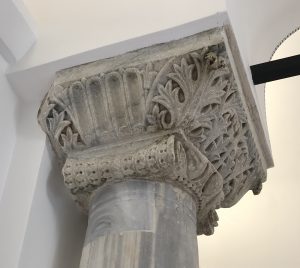
The tomb of Sümbül Efendi in the grounds is painted with blue hyacinths, a play on his name, which is Turkish for hyacinth.
Transport info
To explore this area take the suburban train from Sirkeci to Cerrahpaşa or Yenikapı station. You can also take the tram to either Aksaray or Haseki, or catch a bus from Eminönu heading along Cerrahpaşa Caddesi towards Kocamustafapaşa.
Nearby areas
